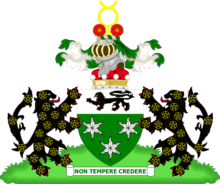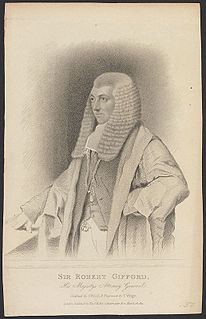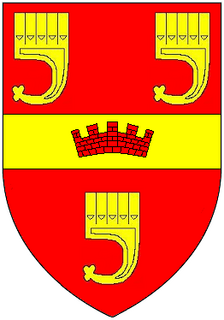Barons Adrian (1955)
- Edgar Douglas Adrian, 1st Baron Adrian (1889–1977)
- Richard Hume Adrian, 2nd Baron Adrian (1927–1995)
 |
|
Baron Adrian, of Cambridge in the County of Cambridge, was a title in the Peerage of the United Kingdom. It was created on 27 January 1955 for the electrophysiologist and Nobel Prize recipient Edgar Adrian. He was succeeded by his only son, the second Baron. He was Professor of cell physiology at the University of Cambridge. He was childless and the title became extinct on his death in 1995.
 |
|

Viscount Chandos, of Aldershot in the County of Southampton, is a title in the Peerage of the United Kingdom and held by a branch of the Lyttelton family. It was created in 1954 for the businessman and public servant Oliver Lyttelton. He was the son of the politician and sportsman Alfred Lyttelton, eighth son of George Lyttelton, 4th Baron Lyttelton, whose eldest son, the 5th Baron Lyttelton, also succeeded his kinsman The 3rd Duke of Buckingham and Chandos as 8th Viscount Cobham in 1889. As of 2017 the title of Viscount Chandos is held by the first Viscount's grandson, the third Viscount, who succeeded his father in 1980. He lost his seat in the House of Lords after the passing of the House of Lords Act of 1999, which removed the automatic right of hereditary peers to sit in the upper chamber of Parliament. However, in 2000 he was given a life peerage as Baron Lyttelton of Aldershot, of Aldershot in the County of Hampshire, and was able to return to the House of Lords, where he now sits on the Labour benches. Lord Chandos is also in remainder to the viscountcy of Cobham and its subsidiary titles the barony of Cobham, the barony of Lyttelton, the barony of Westcote and the baronetcy of Frankley.

Marquess of Linlithgow, in the County of Linlithgow or West Lothian, is a title in the Peerage of the United Kingdom. It was created on 23 October 1902 for John Hope, 7th Earl of Hopetoun. The current holder of the title is Adrian Hope.

Viscount Buckmaster, of Cheddington in the County of Buckingham, is a title in the Peerage of the United Kingdom. It was created in 1933 for the lawyer and Liberal politician and former Lord Chancellor, Stanley Buckmaster, 1st Baron Buckmaster. He had already been created Baron Buckmaster, of Cheddington in the County of Buckingham, in 1915, also in the Peerage of the United Kingdom. His grandson, the third Viscount, was a diplomat. As of 2017 the titles are held by the latter's nephew, the fourth Viscount, who succeeded in 2007.
Viscount Camrose, of Hackwood Park in the County of Hampshire, is a title in the Peerage of the United Kingdom. It was created on 20 January 1941 for the prominent newspaper magnate William Berry, 1st Baron Camrose. He had already been created a Baronet, of Long Cross in the County of Surrey, in the Baronetage of the United Kingdom, on 4 July 1921, and Baron Camrose, of Long Cross in the County of Surrey, on 19 June 1929, also in the Peerage of the United Kingdom. His second son, the third Viscount, disclaimed the peerages in 1995 on succeeding his elder brother. However, he had already been created a life peer as Baron Hartwell, of Peterborough Court in the City of London, on 19 January 1968. On his death in 2001 the life peerage became extinct while he was succeeded in the other titles by his eldest son, the fourth Viscount. The first three Viscounts all headed The Daily Telegraph at one point, the first having purchased it from Harry Levy-Lawson, 1st Viscount Burnham, but in the 1980s they lost control to Conrad Black.

Baron Ellenborough, of Ellenborough in the County of Cumberland, is a title in the Peerage of the United Kingdom. It was created on 19 April 1802 for the lawyer, judge and politician Sir Edward Law, Lord Chief Justice of the King's Bench from 1802 to 1818. His son, the second Baron, notably served as Governor-General of India. On 22 October 1844 the second Baron was created Viscount Southam, of Southam in the County of Gloucester, and Earl of Ellenborough, in the County of Cumberland. These titles were also in the Peerage of the United Kingdom. His only son predeceased him and on his death in 1871 the viscountcy and earldom became extinct.

Baron Gifford, of St Leonard's in the County of Devon, is a title in the Peerage of the United Kingdom. It was created on 30 January 1824 for the lawyer Sir Robert Gifford, who later served as Master of the Rolls. His grandson, the third Baron, was a soldier and colonial administrator and was awarded the Victoria Cross in 1874. On his death the title passed to his younger brother, the fourth Baron, and then to their nephew, the fifth Baron. As of 2010 the title is held by the latter's son, the sixth Baron, who succeeded in 1961. He is a barrister.

Baron Grenfell, of Kilvey in the County of Glamorgan, is a title in the Peerage of the United Kingdom. It was created on 15 July 1902 for the military commander Sir Francis Grenfell. His eldest son, the second Baron, was Deputy Speaker of the House of Lords and Chairman of Committees from 1963 to 1976. As of 2010 the title is held by the latter's son, the third Baron, who succeeded in 1976. He previously worked for the World Bank. Lord Grenfell lost his seat in the House of Lords after the passing of the House of Lords Act 1999. However, in 2000 he was made a life peer as Baron Grenfell of Kilvey, of Kilvey in the County of Swansea, and was able to return to the House of Lords.
Baron Gainford, of Headlam in the County of Durham, is a title in the Peerage of the United Kingdom. It was created on 3 January 1917 for the Liberal politician Jack Pease, a member of the Darlington Pease family. He notably served as President of the Board of Education from 1911 to 1915. Pease was the second son of Sir Joseph W. Pease, 1st Baronet, and the grandson of Joseph Pease, while Arthur Pease was his uncle and Sir Arthur Francis Pease, 1st Baronet, Beaumont Pease, 1st Baron Wardington, and Herbert Pike Pease, 1st Baron Daryngton, were his first cousins. The third baron was a former member of the London County Council and of the Greater London Council. As of 2013 the title is held by his younger brother, the fourth baron, an architect and town planner; County Planning Officer for Ross and Cromarty 1967-1975 and Scottish Office Inquiry Reporter 1978-1993.

Baron Stratheden, of Cupar in the County of Fife, and Baron Campbell, of St Andrews in the County of Fife, are two titles in the Peerage of the United Kingdom. The titles were created in 1836 and 1841 respectively. The barony of Stratheden was created for the Hon. Mary, Lady Campbell, wife of the prominent lawyer and Whig politician Sir John Campbell, and daughter of James Scarlett, 1st Baron Abinger. Sir John Campbell, who in 1836 served as Attorney-General in the Whig administration of Lord Melbourne, had twice been overlooked for the office of Master of the Rolls, and was about to tender his resignation to Melbourne as a result of this. However, he was talked out of resigning when it was decided that, in recognition of the value of his services, his wife should be raised to the peerage. Five years later he was himself created Baron Campbell on his appointment as Lord Chancellor of Ireland. He later held office as Lord High Chancellor of Great Britain.
Baron Swaythling, of Swaythling in the County of Southampton, is a title in the Peerage of the United Kingdom. It was created in 1907 for the British Jewish Liberal politician, banker and philanthropist, Sir Samuel Montagu, 1st Baronet. He had already been created a Baronet, of South Stoneham House in the County of Southampton and of Kensington Palace Gardens in the County of London, in 1894. As of 2010, the titles are held by his great-great-grandson, the fifth Baron, who succeeded his father in 1998.
Baron Palmer, of Reading in the County of Berkshire, is a title in the Peerage of the United Kingdom. It was created in 1933 for the businessman and patron of music, Sir Ernest Palmer, 1st Baronet. He had already been created a baronet, of Grosvenor Crescent in the City of Westminster, in the Baronetage of the United Kingdom on 26 January 1916. The Palmer family had made its fortune from their ownership of the firm of Huntley & Palmers, biscuit manufacturers, of Reading. As of 2017 the titles are held by the first Baron's great-grandson, the fourth Baron, who succeeded his uncle in 1990. He is the son of the Hon. Sir Gordon Palmer, Lord Lieutenant of Berkshire from 1978 to 1989, younger son of the second Baron. Lord Palmer is one of the ninety elected hereditary peers that remain in the House of Lords after the passing of the House of Lords Act 1999, and sits as a cross-bencher.

Baron Ponsonby of Shulbrede, of Shulbrede in the County of Sussex, is a title in the Peerage of the United Kingdom. It was created in 1930 for the politician Arthur Ponsonby. Ponsonby was the third son of General Sir Henry Ponsonby and the great-grandson of Frederick Ponsonby, 3rd Earl of Bessborough. Frederick Ponsonby, 1st Baron Sysonby, was his elder brother. The first Baron's grandson, the third Baron, was also a Labour politician and notably served as Opposition Chief Whip in the House of Lords in the 1980s. As of 2017 the title is held by the latter's only son, the fourth Baron, who succeeded in 1990. He sat on the Labour benches in the House of Lords prior to the passing of the House of Lords Act 1999, when he lost his seat. However, in 2000 he was given a life peerage as Baron Ponsonby of Roehampton, of Shulbrede in the County of West Sussex, and was able to retake his seat in the House of Lords.
Baron Monkswell, of Monkswell in the County of Devon, is a title in the Peerage of the United Kingdom. It was created in 1885 for the lawyer and Liberal politician Sir Robert Collier. His eldest son, the second Baron, served as Under-Secretary of State for War in 1895 in the Liberal administration of Lord Rosebery. His grandson, the fourth Baron, disclaimed the peerage on 7 April 1964. He had earlier been a member of the Essex County Council. As of 2020 the title is held by his grandson, the sixth Baron, who succeeded in that year.
Baron Mottistone, of Mottistone in the County of Southampton, is a title in the Peerage of the United Kingdom. It was created in 1933 for the soldier and Liberal politician J. E. B. Seely. He was the fourth son of Sir Charles Seely, 1st Baronet, and the uncle of Hugh Seely, 1st Baron Sherwood. The fourth Baron, succeeded his half-brother in 1966. He notably served Lord Lieutenant of the Isle of Wight from 1986 to 1995 and as the last Governor of the Isle of Wight between 1992 and 1995 and was succeeded by his son as the fifth Baron, in 2011. In turn, the fifth Baron was succeeded by his elder son in 2013.

Baron Rothschild, of Tring in the County of Hertfordshire, is a title in the Peerage of the United Kingdom. It was created in 1885 for Sir Nathan Rothschild, 2nd Baronet, a member of the Rothschild banking family. He was the first Jewish member of the House of Lords not to have previously converted to Christianity. The current holder of the title is Jacob Rothschild, 4th Baron Rothschild, who inherited the title in 1990.
Baron Rennell, of Rodd in the County of Hereford, is a title in the Peerage of the United Kingdom. It was created in 1933 for the diplomat Sir Rennell Rodd, previously British Ambassador to Italy. His second but eldest surviving son, the second Baron, served as President of the Royal Geographical Society from 1945 to 1948. He had no male issue and was succeeded by his nephew, the third Baron. He was the only surviving son of Commander the Hon. Gustaf Guthrie Rennell Rodd, youngest son of the first Baron. The third Baron was a Scottish international rugby player. As of 2017 the title is held by his son, the fourth Baron, who succeeded in 2006.

Edgar Douglas Adrian, 1st Baron Adrian was an English electrophysiologist and recipient of the 1932 Nobel Prize for Physiology, won jointly with Sir Charles Sherrington for work on the function of neurons. He provided experimental evidence for the all-or-none law of nerves.

Baron Fairhaven, of Anglesey Abbey in the County of Cambridge, is a title in the Peerage of the United Kingdom. It was created in 1961 for Urban Huttleston Broughton, 1st Baron Fairhaven, with remainder to his younger brother, Henry Rogers Broughton (1900–1973). He had already been created Baron Fairhaven, of Lode in the County of Cambridge, in 1929, with remainder to the heirs male of his body.
Baron Glendevon, of Midhope in the County of Linlithgow, is a title in the Peerage of the United Kingdom. It was created on 16 July 1964 for the Conservative politician Lord John Hope. He was the younger twin son of Victor Hope, 2nd Marquess of Linlithgow. As of 2017 the title is held by his younger son, the third Baron, who succeeded his elder brother in 2009.

Richard Hume Adrian, 2nd Baron Adrian FRS was a British peer and physiologist.